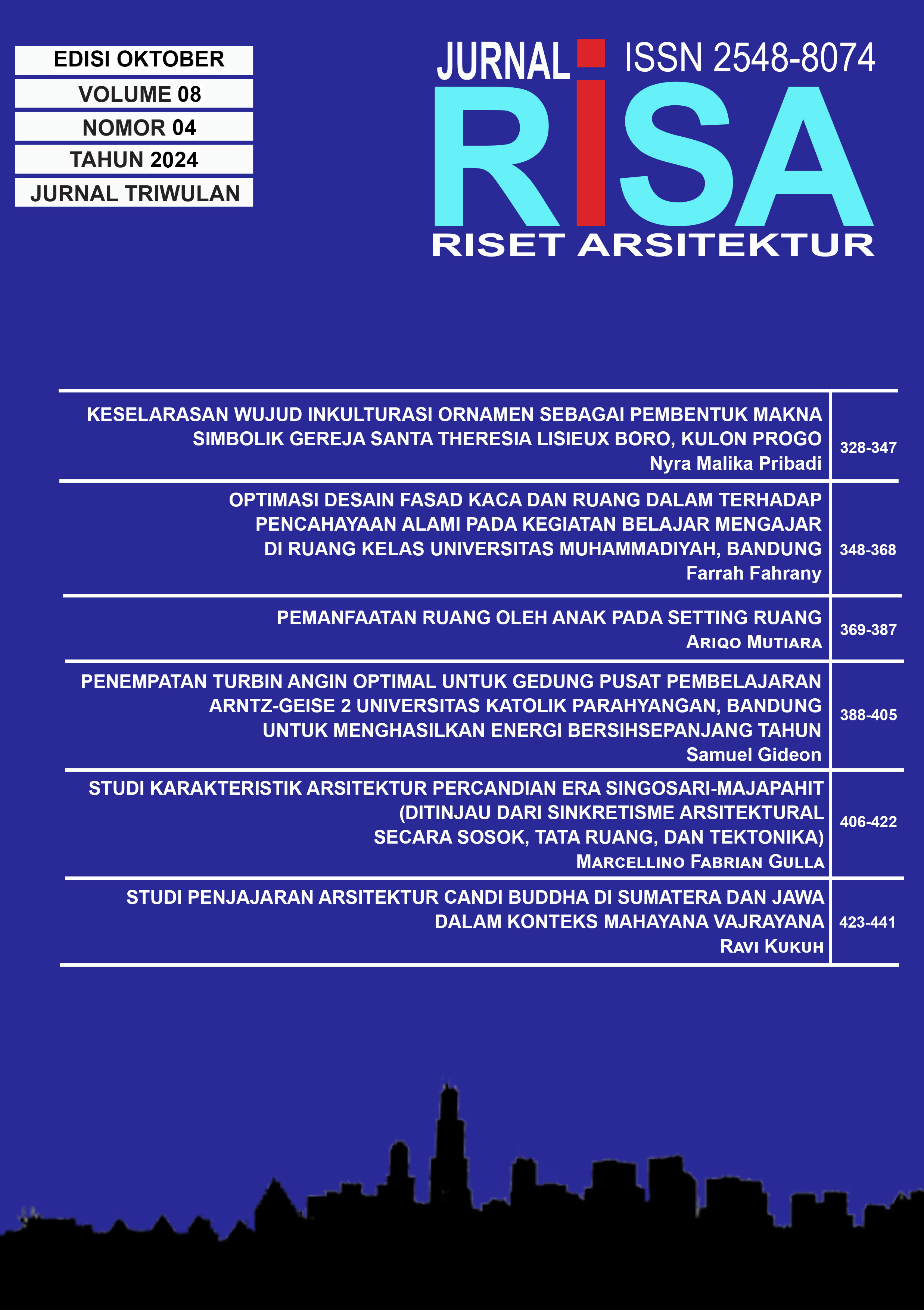OPTIMASI DESAIN FASAD KACA DAN RUANG DALAM TERHADAP PENCAHAYAAN ALAMI PADA KEGIATAN BELAJAR MENGAJAR DI RUANG KELAS UNIVERSITAS MUHAMMADIYAH, BANDUNG
DOI:
https://doi.org/10.26593/risa.v8i04.8578.348-368Abstrak
Abstrak - Indonesia terletak di wilayah beriklim tropis yang menerima banyak cahaya alami dari pantulan cahaya matahari. Cahaya alami yang berlimpah ini dapat dimanfaatkan sebagai penerangan pada bangunan dan dapat menghemat energi, khususnya pada bangunan pendidikan seperti pada Universitas Muhammadiyah, Bandung merupakan bangunan dengan fungsi pendidikan dimana fasad nya menggunakan kaca pada sisi-sisinya dengan fungsi ruang di dalamnya yaitu ruang kelas. Ruang kelas pada Bangunan Universitas Muhammadiyah Bandung memiliki dua model unit kelas dengan perbedaan pada desain bukaan sehingga mengakibatkan perbedaan kuat cahaya alami dalam kedua model ruang kelas tersebut, terdapat ruangan yang dilingkupi oleh 2 bukaan kaca berdimensi cukup besar menghadap ke arah Timur, Barat, Utara, Selatan. Lalu terdapat ruang kelas dengan bukaan yang menghadap ke Selatan dimana dimensi bukaannya cukup kecil. Penelitian ini akan dilakukan kajian berupa evaluasi eksisting bangunan, bagaimana fasad kaca dan elemen pelingkup ruang kelas pada bangunan berpengaruh terhadap kuantitas dan kualitas pencahayaan alami. Hasil simulasi akan dikaji dan dilakukan optimasi desain terhadap fasad kaca dan elemen pelingkup ruang kelas dengan berbagai konfigurasi elemen arsitektural. Metode yang digunakan adalah kuantitatif dengan pendekatan eksperimental-simulasi. Model dari bangunan akan dibuat dengan aplikasi SketchUp dan kemudian akan dilakukan simulasi oleh Velux Daylight Visualizer 3. Simulasi dilakukan pertama kepada kedua model ruang kelas eksisting. Hasil dari simulasi menunjukkan adanya permasalahan kualitas dan kuantitas cahaya alami pada kedua model unit ruang kelas yang tidak memenuhi standar. Optimasi desain berupa pengubahan elemen arsitektural dilakukan untuk menyelesaikan masalah kualitas cahaya alami yang meliputi iluminasi dan DF, serta kuantitas cahaya alami meliputi kemerataan cahaya dan rasio kontras silau. Unit kelas 1 melakukan modifikasi warna perabot, modifikasi bukaan, penambahan light shelf, serta menggabungkan keseluruhan modifikasi. Unit kelas 2 dilakukan modifikasi kaca, modifikasi warna perabot, serta menggabungkan keseluruhan modifikasi. Hasil optimasi menunjukan modifikasi warna perabot memperbaiki belum mencapai standar kualitas cahaya dan memperbaiki sudah mencapai standar kuantitas cahaya kedua model ruang kelas. Modifikasi dimensi bukaan pada unit kelas 1 memperbaiki belum mencapai standar kualitas cahaya, dan sedikit memperbaiki hingga memperbaiki belum mencapai standar kuantitas cahaya. Penambahan light shelf pada model unit kelas 1 tidak memperbaiki kualitas cahaya dan memperburuk hingga sedikit memperbaiki kuantitas cahaya. Modifikasi kaca pada unit kelas 2 memperburuk kualitas cahaya dan tidak memperbaiki kuantitas cahaya. Penggabungan keseluruhan modifikasi dapat memperbaiki permasalahan kualitas dan kuantitas cahaya kedua model unit kelas.
Kata Kunci: kualitas kuantitas pencahayaan alami, fasad kaca bangunan, ruang dalam, ruang kelas.
File Tambahan
Diterbitkan
Terbitan
Bagian
Lisensi
Hak Cipta (c) 2024 Farrah Fahrany

Artikel ini berlisensiCreative Commons Attribution-NonCommercial-ShareAlike 4.0 International License.












